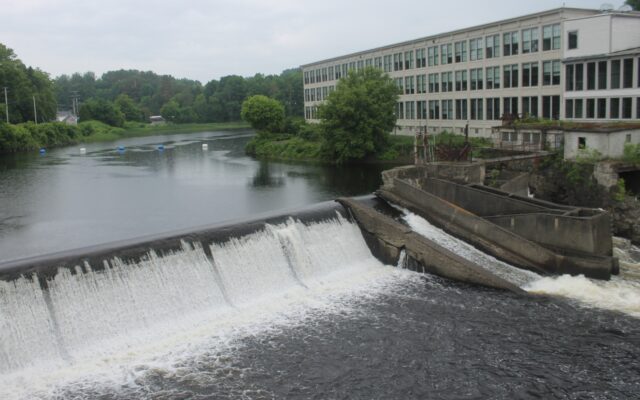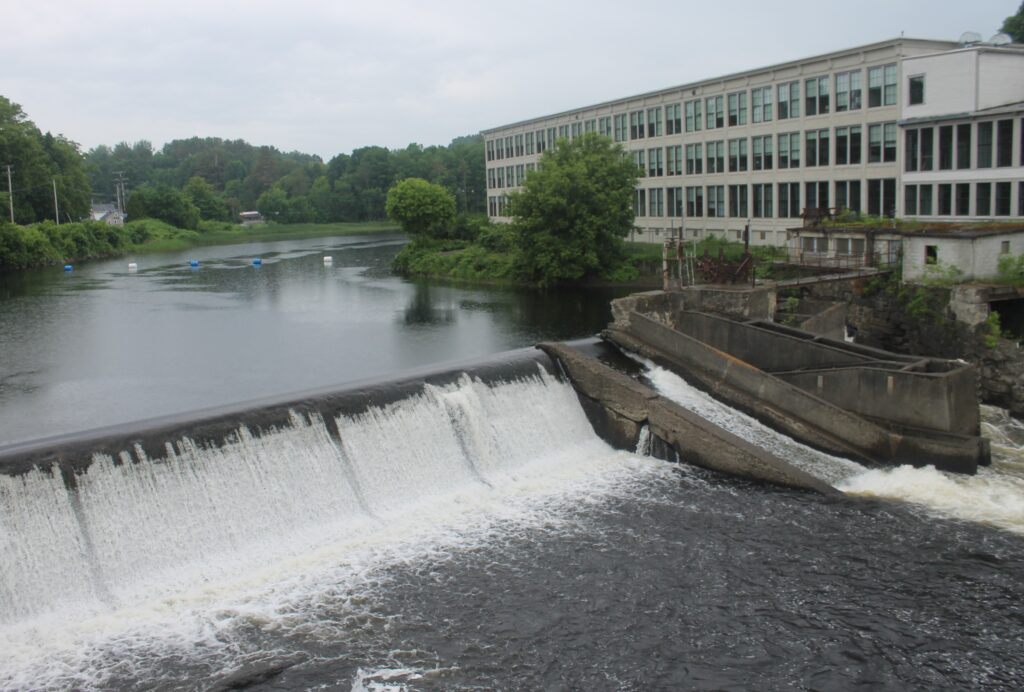
Dover-Foxcroft takes next step in deciding fate of ailing dam
DOVER-FOXCROFT — The wording for two articles concerning the future of the Mayo Mill Dam and associated costs to be voted on at the town’s annual meeting were approved by the select board on Monday evening.
The town meeting, scheduled for 9 a.m. on Saturday, April 26, is the first in a two-step process. Financial numbers and other articles approved that day are moved to a referendum vote on Tuesday, June 10 for final approval.
The first of these articles, if passed, would authorize the select board to raise and appropriate $250,000 and have the authority to borrow up to $250,000 (for a total not to exceed $500,000) to begin consulting work to surrender the dam’s Federal Energy Regulatory Commission license.
The second dam article asks residents to authorize the select board to borrow up to $9 million for the retention and repair of the dam. The amount to be borrowed is based on the total estimated project costs but excludes financing costs and potential funding offsets.
Dover-Foxcroft voters rejected a referendum article last June to remove the Mayo Mill Dam, indicating they were in favor of using tax money to fund studies, permits and repair costs for the structure. No financial figures were included in the 2024 ballot question.

DAM DECISIONS — The language for a pair of town meeting warrant articles concerning the Mayo Mill Dam on the Piscataquis River have been finalized. The Dover-Foxcroft annual town meeting will be at 9 a.m. on Saturday, April 26 in the municipal building gymnasium.
A yes vote on the second dam-related article authorizes the town to pursue said borrowing for retention and repair. A no vote authorizes the Dover-Foxcroft Select Board to remove the Mayo Mill Dam without using local taxpayer funding, including by entering into an agreement with outside parties for the removal of the dam and to develop a plan for a restored riverfront to be negotiated and approved by the select board acting in the best interests of the town.
If approved, the projected annual cost to the town for the dam’s repair is $664,000, which will result in an expected rise in property taxes (based on 2025 assessments) of approximately 9 percent, or 1.5 mil, for property owners for a period of 25 years.
“It’s a guessing game, it could be two years to get proposals out,” Select Vice Chair and Dam Committee Chair Steve Grammont said regarding the cost for the article. “We erred on the side of being a bit higher,” he said, not wanting the public to think it had been undersold on dam repair costs.
Financing the $9 million over 25 years, with a 5 percent interest rate, would put the project cost at $14,107,600, between the $9 million principal and $5,107,600 in interest.
“We felt that we needed to ask people up front for the spending authority,” Grammont said about the 10th article. Otherwise it could be problematic to get contractors on board if funding had to be approved by citizens piece meal, he said.
It’s unclear when the cost would be reflected in taxes if the article passes, Grammont said.
The cost to surrender the license for the first dam-related article is yet to be determined, but expenses for consults, legal work, engineering studies and more could total between $300,000 and $500,000.
The board had opted to abandon plans to pursue hydropower at the Mayo Mill Dam due in large part to a lack of financial sustainability. Renewal could have cost $1.2 million.
A consultant will need to be hired for the license surrender no matter what else happens with the dam in the future, Grammont said.
“Article 9, we need this money to get started no matter what happens with the other,” Selectperson Emery Cox said.
Letters will be sent to voters and property owners to inform them of the two questions.
The dam committee, which will meet next on Tuesday, April 29, has been discussing all scenarios should articles 9 and 10 both be turned down, or one approved and not the other.
“We look forward to seeing as many folks as possible,” Interim Town Manager Alsina Brenenstuhl said about the town meeting, as attendees will be able to ask questions when the articles come up for a discussion and vote.
Other opportunities to learn more will be held prior to June 10, Select Chair Tom Lizotte said. Public hearings on the June ballot are held in May, either as part of a regular select board meeting or on another night.
“As a town government we can offer the opportunity, people have to take advantage of it,” Lizotte said.
In other business, the select board endorsed the “Two Lights for Tomorrow” nationwide initiative to commemorate the 250th anniversary of the events that began the American Revolution.
Eric Boothroyd of the local chapter of the Sons of Union Veterans of the Civil War explained the event. There are no longer any area chapters of the Sons of the American Revolution or Daughters of the American Revolution, he said.
On the night of April 18, 1775, two lanterns were hung in the tower of Boston’s Old North Church as a signal to Paul Revere, across the river in Charlestown, that the British regulars were moving “by sea” across the Back Bay to Cambridge in order to begin their march to seize powder and munitions in Concord. This signal sparked a chain of events that led to the confrontations at Lexington and Concord, the beginning of the American Revolution and the ultimate birth of the nation.
Two and a half centuries later Dover-Foxcroft will commemorate this event with “Two Lights For Tomorrow,” a uniting call to action to recognize and remind ourselves that our history is about working together for a promising future.
The local chapters of the Sons of Union Veterans of the Civil War, Daughters of Union Veterans of the Civil War and the American Legion are partnering with the Thompson Free Library, Central Hall Commons, the Dover-Foxcroft Historical Society and the Dover-Foxcroft Congregational Church to place two lanterns at each of these downtown locations on Friday evening.
The event starts at the library at 6 p.m. with a reading of “Paul Revere’s Ride” and the placement of the first lights. The procession on foot goes to the other locations and ends at the church at 6:45 p.m., where the proclamation from the select board will be read and the final lamps are placed. All are invited to attend.
Communities and individuals can participate by displaying two lights on the evening of April 18 through the morning of April 19.
“Two Lights For Tomorrow” is a sanctioned event from the Maine Semiquincentennial Commission.
“I’m aware of only seven Maine communities having formal ‘Two Lights for Tomorrow’ ceremonies,” Boothroyd said before reading the proclamation.
“The fact that we won the American Revolution against the British Empire is still astonishing,” Lizotte said, saying it is nice to be reminded of the country’s history.
The select board gave its approval to a request for signs for the Piscataquis Area Community Center. Once the municipality gives its okay then the permission can be sought from the Maine Department of Transportation with the center to fund the signs.
The signs would be placed on North St. near the intersection with Morton Ave. to guide travelers to the nearby Park St. facility.
A future agenda item will likely concern granting a day’s ATV access from the center campus to the nearby trail, via either Mechanic or Forest streets. A community outdoor day is being planned with the Dover Rovers ATV Club, Center Executive Director Manda Stewart said, with the date and other details to be determined.
“Everything is going really, really well, it’s packed,” Stewart said about the facility.
The pool is expected to open in June, Stewart said, saying this is the question that everyone has. Cracks are being worked on in order to be sealed.
“We want to remind people of the necessity of building permits as well as burning permits,” Selectperson Jane Conroy said in the protection committee report.
Burn permits can be obtained online through the Department of Agriculture, Conservation and Forestry, Maine Forest Service. This method is preferred compared to calling the fire department, Cox said.
“The important thing is you get one,” Conroy said.